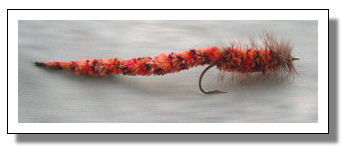
The Wiggle Worm shown here imitates the numerous seaworm (also called sandworm or clamworm) species found throughout the year on most mud flats, mussel beds, and in many other areas where they become prey for stripers and other game fish. These worms are not to be confused with the epitoke stage of the spawning sandworm, which many anglers are aware of as the "worm hatch." These latter are quite different in color, size, and configuration. (Later on in the spring, when this activity usually takes place, I'll write a short piece and give further dressings.)
This very simple fly has become one of my recent favorites to fish and I recommend it as a worthy addition to your fly fishing arsenal. I tie it using a super-soft, two-strand very plush chenille that I call Wiggle Worm chenille. (I carry it among my fly tying materials.) You can off course substitute other chenilles. The chenille should sufficiently thick and preferably variegated in color. To reduce water absorbancy and rot choose chenille composed of synthic material (such as a polyester or acrylic) over cotton.
Given below are two dressings, one for the Light Wiggle Worm and one for the Dark. Try both and see which works best for you. I also fish these worms in fresh water for bass and trout and I've given both the fresh water and salt water hook recommendations. If a weighted fly is desired, tie on lead or tungsten barbell eyes a couple of eye lengths back from the eye before tying the fly according to the instructions below.
Light Wiggle Worm
|
Hook: |
Mustad #34011 (salt), #2-1/0, Daiichi #2141 (fresh) #2-1 |
|
Thread: |
Danville 's 3/0 monocord, brown or black |
|
Body and Tail: |
Orange Wiggle Worm chenille |
|
Hackle: |
Narrow orange-rust-dyed grizzly |
|
Head: |
Dubbed and picked-out mix of black-orange-brown blended dubbing, with a little peacock blaze GSS mixed in as well. |
Dark Wiggle Worm
|
Hook: |
Mustad #34011 (salt), #2-1/0,Daiichi #2141 (fresh) #2-1 |
|
Thread: |
Danville 's 3/0 monocord, brown or black |
|
Body and Tail: |
Brown Wiggle Worm chenille |
|
Hackle: |
Narrow brown or rust-dyed grizzly saddle feather |
|
Head: |
Dubbed and picked-out mix of black-orange-red and brown blended dubbing, with a little peacock blaze GSS mixed in as well. |
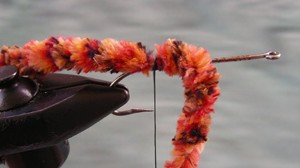 Starting just behind the eye and working back, cover the shank with wraps of thread, stopping just before the bend of the hook. Cut an approximately 9" length of chenille. Determine how long you want your "tail" to be (3"-4" is a good average) and tie chenille in just forward of the bend so that a length is hanging off the rear end to serve as your "tail."
Starting just behind the eye and working back, cover the shank with wraps of thread, stopping just before the bend of the hook. Cut an approximately 9" length of chenille. Determine how long you want your "tail" to be (3"-4" is a good average) and tie chenille in just forward of the bend so that a length is hanging off the rear end to serve as your "tail."
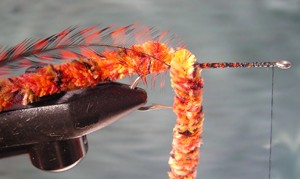 Tie saddle feather in by the tip and trim excess.
Tie saddle feather in by the tip and trim excess.
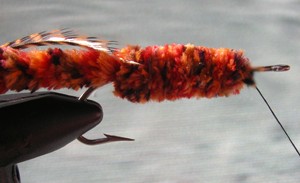 Wind chenille forward over shank, stopping a couple of eye lengths back from the eye. Trim excess.
Wind chenille forward over shank, stopping a couple of eye lengths back from the eye. Trim excess.
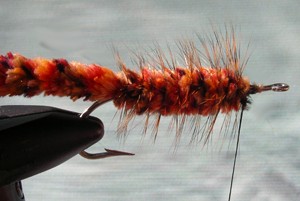 Wind hackle over chenille, taking a few extra turns in front of chenille body. Trim excess.
Wind hackle over chenille, taking a few extra turns in front of chenille body. Trim excess.
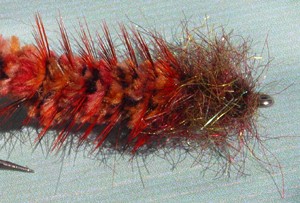 Dub on a sufficient quantity of blended dubbing, enough to make a head that is roughly the same diameter as the chenille. Whip finish small thread head just behind eye. Pick fibers out from all sides and trim if necessary. Apply a drop of head cement to thread head area.
Dub on a sufficient quantity of blended dubbing, enough to make a head that is roughly the same diameter as the chenille. Whip finish small thread head just behind eye. Pick fibers out from all sides and trim if necessary. Apply a drop of head cement to thread head area.
Apply a couple of drops of head cement to the tail area. Allow a few seconds for it to seep into the material and then roll the chenille between your fingers to create a tapered effect.
Note: The head cement "sealing" of the tail area is fairly durable but if you catch enough fish or snap the fly against enough rocks it will eventually wear off. When it does, simply wash the fly in fresh water, allow it to dry thoroughly, and then re-apply the head cement.






